The best water flow rates for micro-hydro systems range from 5 to 300 gallons per minute, catering to various energy needs and property sizes. You'll find low flow rates (5-10 GPM) suitable for small streams, while moderate flows (20-40 GPM) can power most household appliances. High flow rates (50-100 GPM) are ideal for larger properties, and very high flows (150-300 GPM) can support small commercial operations. Consider seasonal variations, minimum flow for turbine efficiency, and suitable flow for maximum power when designing your system. Each flow rate category offers unique benefits and challenges, influencing your system's performance and potential energy output. Exploring these options further will reveal the ideal solution for your specific needs.
Low Flow: 5-10 Gallons/Minute
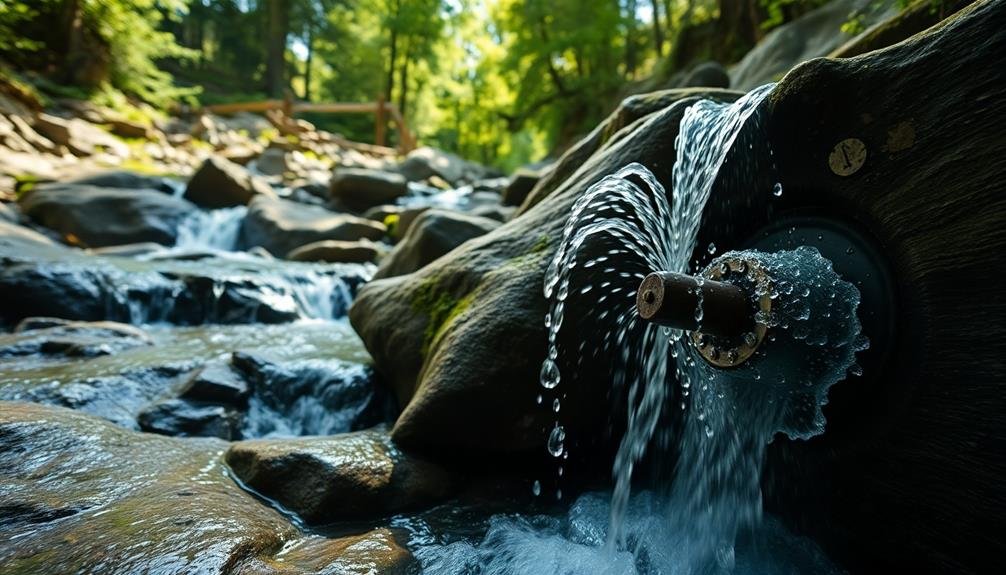
With flows between 5-10 gallons per minute, you're looking at the lower end of micro-hydro potential. These systems are suitable for small streams or springs with consistent flow. You'll need to maximize efficiency to generate useful power at this level.
Low-flow systems typically use impulse turbines like Pelton wheels or turgo runners. These turbines convert the water's kinetic energy into rotational motion. To increase power output, you'll want to focus on head height – the vertical distance water falls. A higher head can compensate for lower flow rates.
You can expect to generate around 100-200 watts with a 5-10 GPM flow, assuming a reasonable head height. This power output is sufficient for LED lighting, small appliances, or charging batteries. It's ideal for off-grid cabins or supplementary power in rural areas.
When designing your system, consider using a battery bank to store excess energy. This approach allows you to accumulate power during periods of low demand and use it later when needed.
You'll also want to implement a robust filtration system to prevent debris from clogging your turbine, ensuring consistent performance even with limited water resources.
Moderate Flow: 20-40 Gallons/Minute
Moderate flow rates of 20-40 gallons per minute open up more possibilities for micro-hydro power generation. With this range, you'll find a broader selection of turbines and generators suitable for your system.
These flow rates can typically produce between 200 and 800 watts of power, depending on the available head (vertical drop) and the efficiency of your equipment.
At this level, you can power most essential household appliances and lighting. You'll need to take into account a Pelton wheel or Turgo turbine, which are well-suited for moderate flows with medium to high heads.
These turbines can handle the increased water volume efficiently, converting more of the water's energy into electricity.
When designing your system, pay attention to pipe sizing. You'll need larger diameter pipes to accommodate the increased flow without excessive friction losses.
It's essential to match your turbine and generator to your specific site conditions for best performance. Don't forget to factor in seasonal variations in water flow, as this can affect your system's output throughout the year.
With proper planning and equipment selection, a moderate flow micro-hydro system can provide a reliable and sustainable source of off-grid power for your home or small business.
High Flow: 50-100 Gallons/Minute
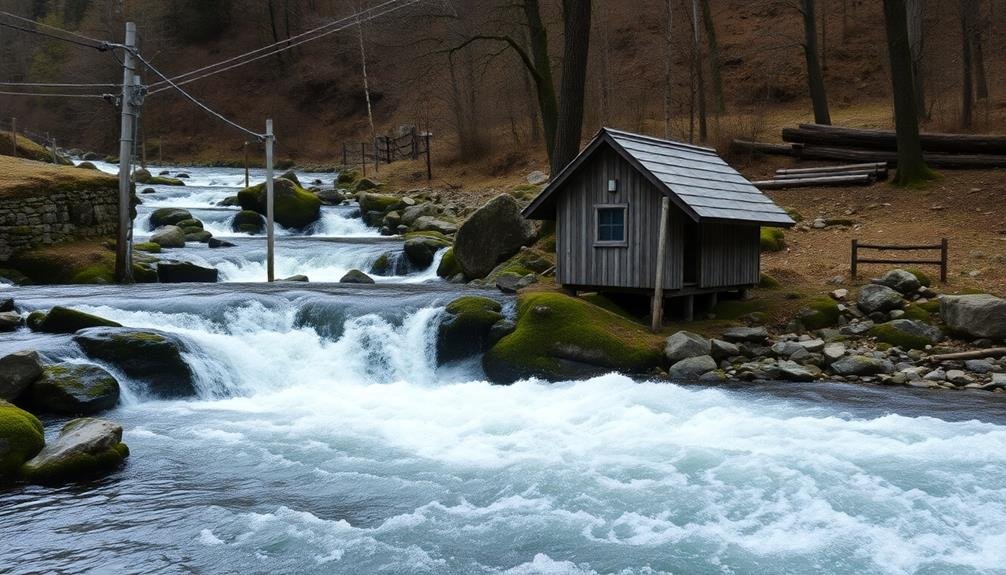
If you're managing a larger property or aiming for high power generation, you'll want to contemplate a high flow rate of 50-100 gallons per minute.
This range offers significant potential for electricity production, capable of powering multiple buildings or energy-intensive equipment.
You'll need access to a substantial water source, such as a fast-moving river or large stream, to achieve these flow rates.
Optimal for Larger Properties
Larger properties with access to substantial water resources can benefit greatly from high-flow micro-hydro systems. If you've got a flow rate between 50-100 gallons per minute, you're in an ideal position to harness significant power for your property.
These higher flow rates can generate enough electricity to power multiple buildings or even small communities, making them perfect for larger estates, farms, or remote villages.
When considering a high-flow micro-hydro system for your larger property, keep these key points in mind:
- Increased power output: You'll generate more electricity, potentially meeting all your energy needs.
- Greater flexibility: You can power multiple buildings or energy-intensive equipment.
- Higher initial cost: These systems require larger turbines and more extensive infrastructure.
- Potential for grid connection: Excess power can be sold back to the grid in some locations.
High Power Generation Potential
You're entering the big leagues with water flow rates between 50-100 gallons per minute. These high flow rates offer exceptional power generation potential for micro-hydro systems.
With this volume of water, you can expect to produce anywhere from 2 to 10 kilowatts of electricity, depending on the available head and system efficiency.
At this level, you'll have enough power to fully supply an average home's energy needs and potentially sell excess electricity back to the grid. You can run multiple high-wattage appliances simultaneously, power workshop tools, or even support small agricultural operations.
The consistent energy output allows for reliable off-grid living or significant reduction in utility bills.
To harness this power effectively, you'll need robust equipment. Invest in a high-quality turbine designed for these flow rates, such as a Pelton or Turgo wheel.
Confirm your penstock can handle the water volume without excessive friction losses. You'll also require a more sophisticated control system and larger inverter to manage the increased power output.
While the initial investment may be higher, the long-term energy savings and potential income from excess power make it a worthwhile consideration for those with suitable water resources.
Requires Substantial Water Source
Accessing water sources capable of delivering 50-100 gallons per minute requires careful thought and planning.
You'll need to assess your property's water resources and guarantee they can sustain this high flow rate consistently. Streams, rivers, or large springs are typically necessary to achieve these volumes.
It's vital to conduct thorough measurements and evaluations throughout different seasons to confirm the reliability of your water source.
When seeking a substantial water source for your micro-hydro system, keep these key points in mind:
- Seasonal variations: Water flow can fluctuate considerably between wet and dry seasons, affecting your system's output.
- Environmental impact: High flow rates may have consequences for local ecosystems, so you'll need to take into account wildlife and habitat preservation.
- Legal requirements: Obtaining necessary permits and water rights is essential before tapping into large water sources.
- System design: You'll need to carefully engineer your intake, penstock, and turbine to handle these higher flow rates efficiently.
Very High Flow: 150-300 Gallons/Minute
Very high flow rates of 150-300 gallons per minute offer the maximum power generation potential for micro-hydro systems.
You'll find these flows suitable for larger properties with significant water resources and energy needs.
With such high flow rates, you can power multiple buildings or even sell excess electricity back to the grid, making your system more economically viable.
Maximum Power Generation Potential
Micro-hydro systems operating at very high flow rates of 150-300 gallons per minute offer impressive power generation potential.
With these flow rates, you'll typically achieve outputs ranging from 5 to 20 kilowatts, depending on the available head and system efficiency. This level of power generation can easily meet the electricity needs of a large home, small farm, or even a small commercial operation.
To enhance your system's power generation potential, consider these key factors:
- Head: Increase the vertical drop between your water source and turbine to boost power output.
- Pipe diameter: Use larger pipes to reduce friction losses and maintain higher flow rates.
- Turbine efficiency: Choose a high-quality turbine designed for your specific flow and head conditions.
- System maintenance: Regularly clean intake screens and inspect components to guarantee peak performance.
Suitable for Larger Properties
With ample water resources at their disposal, larger properties are ideally suited for micro-hydro systems operating at very high flow rates of 150-300 gallons per minute.
These systems can generate significant amounts of electricity, often enough to power entire households or small farms.
If you're fortunate enough to own a large property with a suitable water source, you'll benefit from the increased energy output these high-flow systems provide.
You can expect to generate between 5 and 10 kilowatts of power, depending on the head (vertical drop) and specific flow rate of your water source.
To harness this potential, you'll need to invest in larger turbines and more robust infrastructure.
Pelton wheels or crossflow turbines are typically used for these high-flow applications.
You'll also require larger pipelines to accommodate the increased water volume.
Remember that with greater flow comes greater responsibility.
You'll need to carefully manage your water resource to guarantee sustainable use and minimize environmental impact.
Consider implementing a fish-friendly intake system and maintaining proper water levels in your stream or river.
Seasonal Variations in Flow Rates
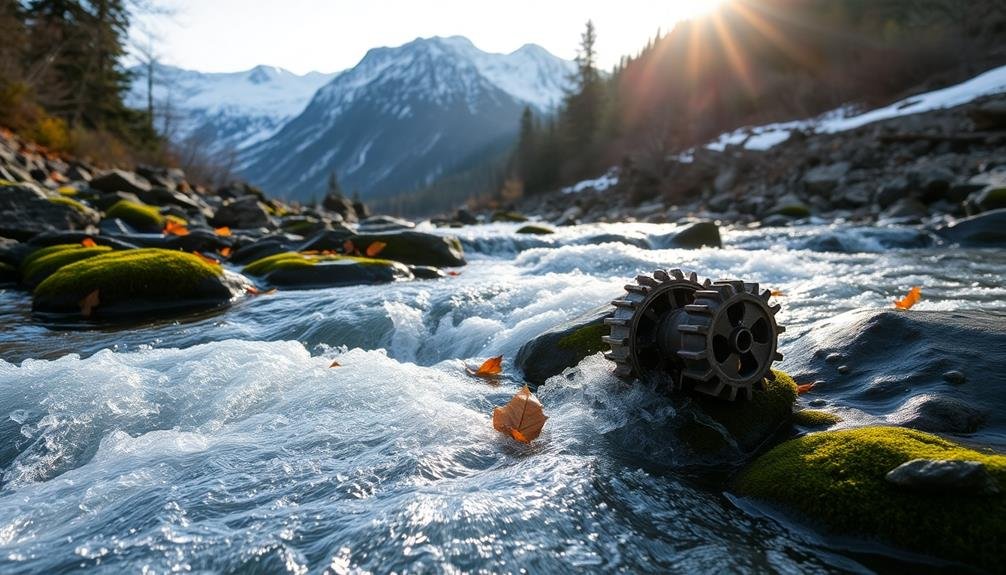
Nature's ebb and flow directly impacts micro-hydro systems' performance throughout the year. You'll need to account for these seasonal variations when planning and operating your system. Water flow rates can fluctuate dramatically, affecting your power output and system efficiency.
To manage seasonal variations effectively:
- Conduct a year-round water flow study
- Design your system for the lowest expected flow rate
- Install a flow control device to regulate excess water
- Consider energy storage solutions for low-flow periods
During spring runoff, you might experience abundant water flow, potentially overwhelming your system. Conversely, late summer and winter months often bring reduced flow rates, limiting power generation.
It's essential to understand your area's precipitation patterns and how they affect your water source.
You can mitigate the impact of seasonal variations by implementing a hybrid system, combining micro-hydro with solar or wind power. This approach guarantees a more consistent energy supply throughout the year.
Additionally, regular maintenance and monitoring of your system will help you adapt to changing conditions and optimize performance across seasons.
Minimum Flow for Turbine Efficiency
Turbines, the heart of micro-hydro systems, require a minimum water flow to operate efficiently. This threshold varies depending on the turbine type and size. For most small-scale systems, you'll need at least 20-30 liters per second to generate useful power.
Pelton wheels, common in high-head, low-flow situations, can operate with as little as 2-3 liters per second. Crossflow turbines, suitable for medium-head sites, typically need 20-50 liters per second. Francis turbines, used in larger systems, may require 100 liters per second or more.
To determine your site's minimum flow, you'll need to measure the stream's flow rate during dry seasons. If it falls below your turbine's threshold, you might consider installing a storage system or opting for a different turbine type.
Optimal Flow for Maximum Power
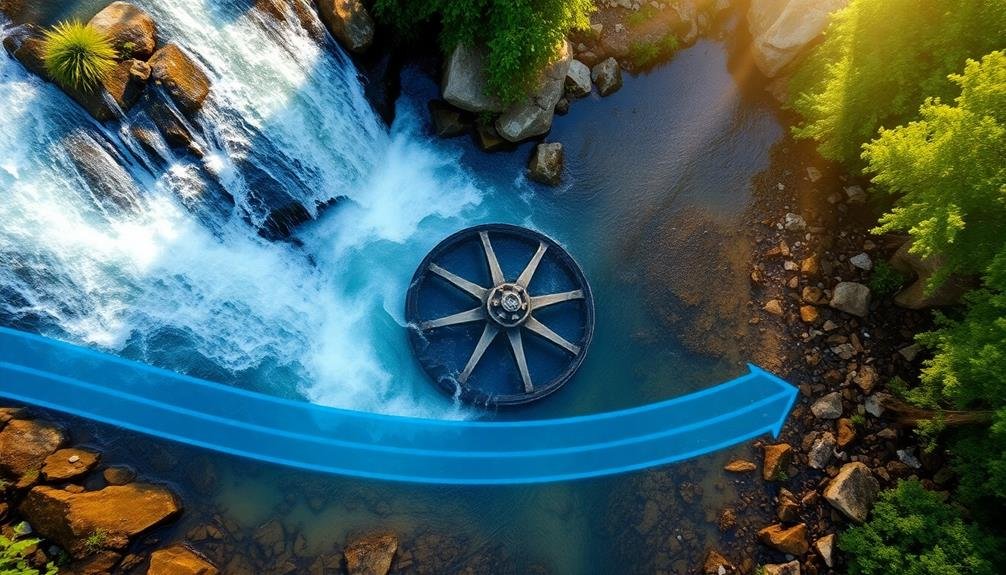
While minimum flow rates guarantee turbine operation, ideal flow rates maximize power output. To achieve optimal flow for maximum power in your micro-hydro system, you'll need to take into account several factors. These include your turbine's design specifications, the head (vertical drop) available, and the seasonal variations in water flow.
To determine the ideal flow rate for your system:
- Consult your turbine manufacturer's performance curves
- Measure your site's available head accurately
- Calculate the theoretical power output using the power equation
- Monitor seasonal flow patterns to guarantee consistent performance
You'll find that there's often a sweet spot where increasing flow doesn't greatly boost power output. This is due to the diminishing returns in efficiency as you approach the turbine's maximum capacity.
It's vital to strike a balance between flow rate and system efficiency to maximize power generation.
Frequently Asked Questions
How Do I Measure the Flow Rate of My Water Source?
You can measure your water source's flow rate using a bucket method. Time how long it takes to fill a container of known volume. Alternatively, you can use a flow meter or weir for more precise measurements.
What Factors Affect the Choice of Turbine for Different Flow Rates?
When choosing a turbine, you'll need to evaluate your water's flow rate and head. High-flow, low-head sites suit impulse turbines, while low-flow, high-head locations work better with reaction turbines. Your site's specific conditions will determine the best option.
Can I Combine Multiple Water Sources to Increase Flow Rate?
Yes, you can combine multiple water sources to increase flow rate. You'll need to carefully design your system to merge streams effectively. It's important to take into account the distance, elevation, and seasonal variations of each source when planning your project.
How Does Water Pressure Impact the Effectiveness of Different Flow Rates?
Water pressure greatly affects flow rates' effectiveness. You'll find higher pressure increases power output, even with lower flow rates. It's essential you consider both factors when designing your system, as they work together to determine overall efficiency.
Are There Environmental Regulations to Consider When Harnessing Water Flow?
You'll need to take into account environmental regulations when harnessing water flow. They'll often limit water usage, protect aquatic life, and regulate dam construction. It's vital to check local, state, and federal laws before starting your project.
In Summary
You've now got a solid grasp of the best water flow rates for micro-hydro systems. Remember, your ideal flow rate depends on your specific setup and power needs. Don't forget to account for seasonal variations and guarantee you're meeting minimum flow requirements for turbine efficiency. By optimizing your system's flow rate, you'll maximize power output and get the most from your micro-hydro installation. Keep these guidelines in mind as you plan or adjust your system.

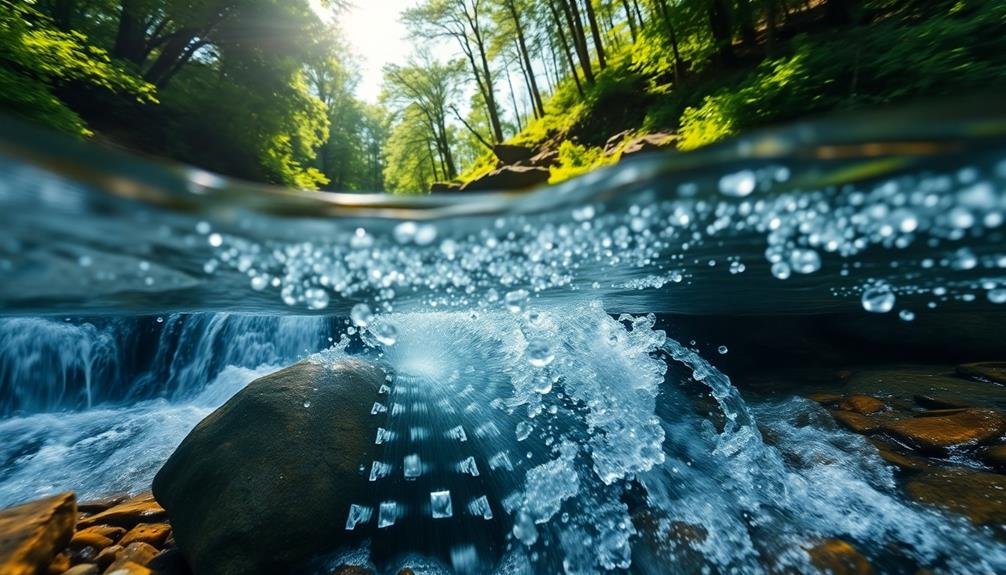


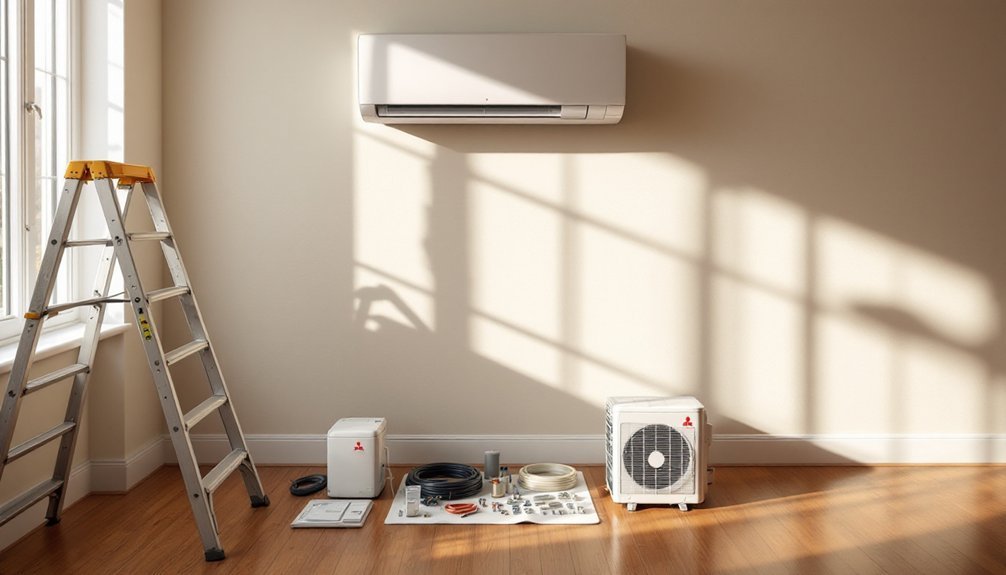
Leave a Reply